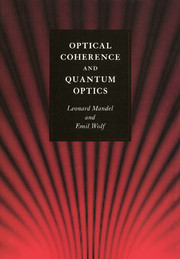Book contents
- Frontmatter
- Contents
- Preface
- 1 Elements of probability theory
- 2 Random (or stochastic) processes
- 3 Some useful mathematical techniques
- 4 Second-order coherence theory of scalar wavefields
- 5 Radiation from sources of any state of coherence
- 6 Second-order coherence theory of vector electromagnetic fields
- 7 Some applications of second-order coherence theory
- 8 Higher-order correlations in optical fields
- 9 Semiclassical theory of photoelectric detection of light
- 10 Quantization of the free electromagnetic field
- 11 Coherent states of the electromagnetic field
- 12 Quantum correlations and photon statistics
- 13 Radiation from thermal equilibrium sources
- 14 Quantum theory of photoelectric detection of light
- 15 Interaction between light and a two-level atom
- 16 Collective atomic interactions
- 17 Some general techniques for treating interacting systems
- 18 The single-mode laser
- 19 The two-mode ring laser
- 20 The linear light amplifier
- 21 Squeezed states of light
- 22 Some quantum effects in nonlinear optics
- References
- Author index
- Subject index
16 - Collective atomic interactions
Published online by Cambridge University Press: 05 April 2013
- Frontmatter
- Contents
- Preface
- 1 Elements of probability theory
- 2 Random (or stochastic) processes
- 3 Some useful mathematical techniques
- 4 Second-order coherence theory of scalar wavefields
- 5 Radiation from sources of any state of coherence
- 6 Second-order coherence theory of vector electromagnetic fields
- 7 Some applications of second-order coherence theory
- 8 Higher-order correlations in optical fields
- 9 Semiclassical theory of photoelectric detection of light
- 10 Quantization of the free electromagnetic field
- 11 Coherent states of the electromagnetic field
- 12 Quantum correlations and photon statistics
- 13 Radiation from thermal equilibrium sources
- 14 Quantum theory of photoelectric detection of light
- 15 Interaction between light and a two-level atom
- 16 Collective atomic interactions
- 17 Some general techniques for treating interacting systems
- 18 The single-mode laser
- 19 The two-mode ring laser
- 20 The linear light amplifier
- 21 Squeezed states of light
- 22 Some quantum effects in nonlinear optics
- References
- Author index
- Subject index
Summary
In the previous chapter we studied the interaction between a single two-level atom and the electromagnetic field, both when the field is treated classically and when it is quantized. We encountered some interesting phenomena such as Rabi oscillations, the a.c. Stark effect, and photon antibunching, all of which have been observed. These phenomena are essentially single-atom effects, in the sense that either they require a single atom for the effect to be observed, as in the last case, or at least they do not require more than one, although a group of atoms may be used in practice.
In this chapter we shall turn to a discussion of some effects that depend in an essential way on the presence of a group of atoms. In some cases we shall find that the group or collective behavior of the atomic system is relatively trivial, in the sense that we can account for the phenomenon by summing the contributions of the individual atoms to the total field, and treating each of them as if it acts almost independently of the others. This is the situation in free induction decay and in the photon echo. In other cases it is essential to include the effect of each atom on all the other atoms, because this modifies the behavior of each in a significant way. These phenomena, such as self-induced transparency and superradiance, are collective effects in a deeper sense. They are sometimes called cooperative effects.
Information
- Type
- Chapter
- Information
- Optical Coherence and Quantum Optics , pp. 805 - 859Publisher: Cambridge University PressPrint publication year: 1995
Accessibility standard: Unknown
Why this information is here
This section outlines the accessibility features of this content - including support for screen readers, full keyboard navigation and high-contrast display options. This may not be relevant for you.Accessibility Information
- 1
- Cited by
